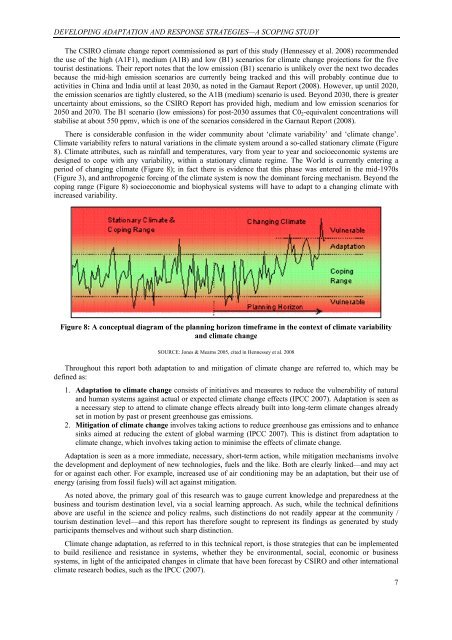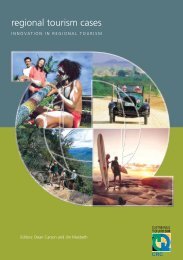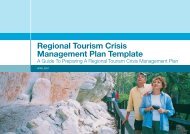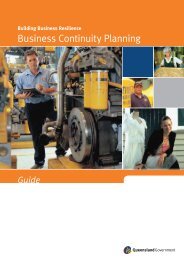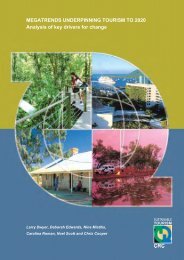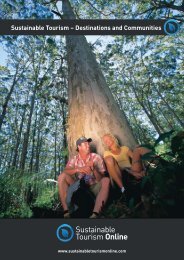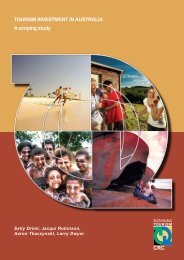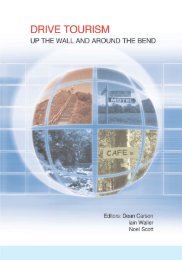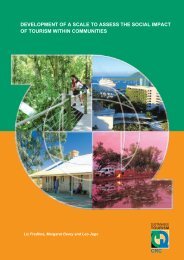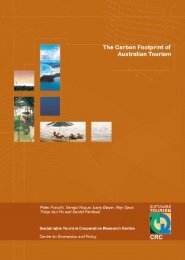The impacts of climate change on australian - Sustainable Tourism ...
The impacts of climate change on australian - Sustainable Tourism ...
The impacts of climate change on australian - Sustainable Tourism ...
You also want an ePaper? Increase the reach of your titles
YUMPU automatically turns print PDFs into web optimized ePapers that Google loves.
DEVELOPING ADAPTATION AND RESPONSE STRATEGIES—A SCOPING STUDY<br />
<str<strong>on</strong>g>The</str<strong>on</strong>g> CSIRO <str<strong>on</strong>g>climate</str<strong>on</strong>g> <str<strong>on</strong>g>change</str<strong>on</strong>g> report commissi<strong>on</strong>ed as part <str<strong>on</strong>g>of</str<strong>on</strong>g> this study (Hennessey et al. 2008) recommended<br />
the use <str<strong>on</strong>g>of</str<strong>on</strong>g> the high (A1F1), medium (A1B) and low (B1) scenarios for <str<strong>on</strong>g>climate</str<strong>on</strong>g> <str<strong>on</strong>g>change</str<strong>on</strong>g> projecti<strong>on</strong>s for the five<br />
tourist destinati<strong>on</strong>s. <str<strong>on</strong>g>The</str<strong>on</strong>g>ir report notes that the low emissi<strong>on</strong> (B1) scenario is unlikely over the next two decades<br />
because the mid-high emissi<strong>on</strong> scenarios are currently being tracked and this will probably c<strong>on</strong>tinue due to<br />
activities in China and India until at least 2030, as noted in the Garnaut Report (2008). However, up until 2020,<br />
the emissi<strong>on</strong> scenarios are tightly clustered, so the A1B (medium) scenario is used. Bey<strong>on</strong>d 2030, there is greater<br />
uncertainty about emissi<strong>on</strong>s, so the CSIRO Report has provided high, medium and low emissi<strong>on</strong> scenarios for<br />
2050 and 2070. <str<strong>on</strong>g>The</str<strong>on</strong>g> B1 scenario (low emissi<strong>on</strong>s) for post-2030 assumes that C0 2 -equivalent c<strong>on</strong>centrati<strong>on</strong>s will<br />
stabilise at about 550 ppmv, which is <strong>on</strong>e <str<strong>on</strong>g>of</str<strong>on</strong>g> the scenarios c<strong>on</strong>sidered in the Garnaut Report (2008).<br />
<str<strong>on</strong>g>The</str<strong>on</strong>g>re is c<strong>on</strong>siderable c<strong>on</strong>fusi<strong>on</strong> in the wider community about ‘<str<strong>on</strong>g>climate</str<strong>on</strong>g> variability’ and ‘<str<strong>on</strong>g>climate</str<strong>on</strong>g> <str<strong>on</strong>g>change</str<strong>on</strong>g>’.<br />
Climate variability refers to natural variati<strong>on</strong>s in the <str<strong>on</strong>g>climate</str<strong>on</strong>g> system around a so-called stati<strong>on</strong>ary <str<strong>on</strong>g>climate</str<strong>on</strong>g> (Figure<br />
8). Climate attributes, such as rainfall and temperatures, vary from year to year and socioec<strong>on</strong>omic systems are<br />
designed to cope with any variability, within a stati<strong>on</strong>ary <str<strong>on</strong>g>climate</str<strong>on</strong>g> regime. <str<strong>on</strong>g>The</str<strong>on</strong>g> World is currently entering a<br />
period <str<strong>on</strong>g>of</str<strong>on</strong>g> changing <str<strong>on</strong>g>climate</str<strong>on</strong>g> (Figure 8); in fact there is evidence that this phase was entered in the mid-1970s<br />
(Figure 3), and anthropogenic forcing <str<strong>on</strong>g>of</str<strong>on</strong>g> the <str<strong>on</strong>g>climate</str<strong>on</strong>g> system is now the dominant forcing mechanism. Bey<strong>on</strong>d the<br />
coping range (Figure 8) socioec<strong>on</strong>omic and biophysical systems will have to adapt to a changing <str<strong>on</strong>g>climate</str<strong>on</strong>g> with<br />
increased variability.<br />
Figure 8: A c<strong>on</strong>ceptual diagram <str<strong>on</strong>g>of</str<strong>on</strong>g> the planning horiz<strong>on</strong> timeframe in the c<strong>on</strong>text <str<strong>on</strong>g>of</str<strong>on</strong>g> <str<strong>on</strong>g>climate</str<strong>on</strong>g> variability<br />
and <str<strong>on</strong>g>climate</str<strong>on</strong>g> <str<strong>on</strong>g>change</str<strong>on</strong>g><br />
SOURCE: J<strong>on</strong>es & Mearns 2005, cited in Hennessey et al. 2008<br />
Throughout this report both adaptati<strong>on</strong> to and mitigati<strong>on</strong> <str<strong>on</strong>g>of</str<strong>on</strong>g> <str<strong>on</strong>g>climate</str<strong>on</strong>g> <str<strong>on</strong>g>change</str<strong>on</strong>g> are referred to, which may be<br />
defined as:<br />
1. Adaptati<strong>on</strong> to <str<strong>on</strong>g>climate</str<strong>on</strong>g> <str<strong>on</strong>g>change</str<strong>on</strong>g> c<strong>on</strong>sists <str<strong>on</strong>g>of</str<strong>on</strong>g> initiatives and measures to reduce the vulnerability <str<strong>on</strong>g>of</str<strong>on</strong>g> natural<br />
and human systems against actual or expected <str<strong>on</strong>g>climate</str<strong>on</strong>g> <str<strong>on</strong>g>change</str<strong>on</strong>g> effects (IPCC 2007). Adaptati<strong>on</strong> is seen as<br />
a necessary step to attend to <str<strong>on</strong>g>climate</str<strong>on</strong>g> <str<strong>on</strong>g>change</str<strong>on</strong>g> effects already built into l<strong>on</strong>g-term <str<strong>on</strong>g>climate</str<strong>on</strong>g> <str<strong>on</strong>g>change</str<strong>on</strong>g>s already<br />
set in moti<strong>on</strong> by past or present greenhouse gas emissi<strong>on</strong>s.<br />
2. Mitigati<strong>on</strong> <str<strong>on</strong>g>of</str<strong>on</strong>g> <str<strong>on</strong>g>climate</str<strong>on</strong>g> <str<strong>on</strong>g>change</str<strong>on</strong>g> involves taking acti<strong>on</strong>s to reduce greenhouse gas emissi<strong>on</strong>s and to enhance<br />
sinks aimed at reducing the extent <str<strong>on</strong>g>of</str<strong>on</strong>g> global warming (IPCC 2007). This is distinct from adaptati<strong>on</strong> to<br />
<str<strong>on</strong>g>climate</str<strong>on</strong>g> <str<strong>on</strong>g>change</str<strong>on</strong>g>, which involves taking acti<strong>on</strong> to minimise the effects <str<strong>on</strong>g>of</str<strong>on</strong>g> <str<strong>on</strong>g>climate</str<strong>on</strong>g> <str<strong>on</strong>g>change</str<strong>on</strong>g>.<br />
Adaptati<strong>on</strong> is seen as a more immediate, necessary, short-term acti<strong>on</strong>, while mitigati<strong>on</strong> mechanisms involve<br />
the development and deployment <str<strong>on</strong>g>of</str<strong>on</strong>g> new technologies, fuels and the like. Both are clearly linked—and may act<br />
for or against each other. For example, increased use <str<strong>on</strong>g>of</str<strong>on</strong>g> air c<strong>on</strong>diti<strong>on</strong>ing may be an adaptati<strong>on</strong>, but their use <str<strong>on</strong>g>of</str<strong>on</strong>g><br />
energy (arising from fossil fuels) will act against mitigati<strong>on</strong>.<br />
As noted above, the primary goal <str<strong>on</strong>g>of</str<strong>on</strong>g> this research was to gauge current knowledge and preparedness at the<br />
business and tourism destinati<strong>on</strong> level, via a social learning approach. As such, while the technical definiti<strong>on</strong>s<br />
above are useful in the science and policy realms, such distincti<strong>on</strong>s do not readily appear at the community /<br />
tourism destinati<strong>on</strong> level—and this report has therefore sought to represent its findings as generated by study<br />
participants themselves and without such sharp distincti<strong>on</strong>.<br />
Climate <str<strong>on</strong>g>change</str<strong>on</strong>g> adaptati<strong>on</strong>, as referred to in this technical report, is those strategies that can be implemented<br />
to build resilience and resistance in systems, whether they be envir<strong>on</strong>mental, social, ec<strong>on</strong>omic or business<br />
systems, in light <str<strong>on</strong>g>of</str<strong>on</strong>g> the anticipated <str<strong>on</strong>g>change</str<strong>on</strong>g>s in <str<strong>on</strong>g>climate</str<strong>on</strong>g> that have been forecast by CSIRO and other internati<strong>on</strong>al<br />
<str<strong>on</strong>g>climate</str<strong>on</strong>g> research bodies, such as the IPCC (2007).<br />
7


